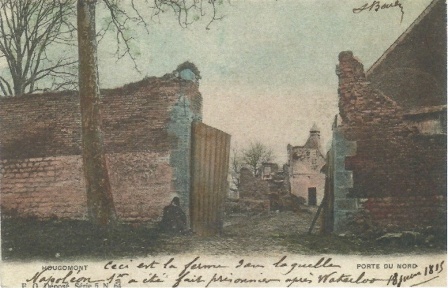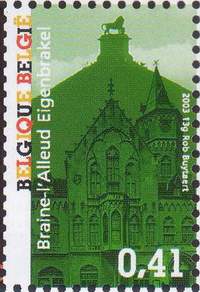Manifestations (préventes, bourses, etc...)
Exposition internationale et bureau temporaire Braphil '15
WISHART A.T. Royal Philatelic Society London
The Buildings and Monuments on the Battlefield of Waterloo
On the 18th of June 1815, one of the largest land battles in history took place between Napoleon’s Armée du Nord and the forces of the Seventh Coalition. It is difficult to determine the size of these armies as contemporary sources vary, but the French army consisted of around 73.000 men with 50.700 infantry, 14.390 cavalry, 8.0500 artillery and engineers and 252 guns. The coalition army comprised of around 25.000 British troops, 6.000 of the King’s German Legion, 17.000 troops from The Netherlands, 11.000 Hanoverians, 6.000 from Brunswick, 3.000 Nassau, 3.000 all under the command of the Duke of Wellington ; with around 50.000 Prussians under Gebhard von Blücher with 156 guns.
It is said that Wellington had selected his perfect position for a battle some time previously using a long ridge running east-west, perpendicular to and bisected by the main road from Genappe to Brussels. Using the reverse slope he was able to draw up his forces in depth in the centre and on the right all the way towards the village of Braine-l’Alleud, concealing his main force from the French.

In front of the ridge, there were three positions that could be fortified. On the extreme right was Hougoumont which was a large well-built farm with a garden and an orchard, and on the extreme left was the hamlet of Papelotte which overlooked the road to Wavre, both of which protected Wellington’s flanks. The third position was on the western side of the main road, being the farmhouse and orchard of La Haye Sainte. Along with a disused sand quarry Wellington had established a formidable position.
Hougoumont – The North Gate.
The French army had formed on the slopes of another ridge to the south with the First and Second Corps drawn up symmetrically about the Brussels road. Further south on the road was the inn called La Belle Alliance which was Napoleon’s headquarters for most of the day. In the rear to the right was the village of Plancenoit and at the extreme right the Bois de Paris.
La Haye-Sainte Farm >>>>>
 At the end of the battle the French lost around 41.000 men with 24.000 to 26.000 killed and wounded including 6.000 to 7.000 taken prisoners ; and 15.000 missing. The Coalition forces lost around 24.000 men with 17.000 (3.500 killed, 10.200 wounded and 3.300 missing) from Wellington’s Army and the Prussian Army losing 7.000 (1.200 killed, 4.400 wounded and 1.400 missing).
At the end of the battle the French lost around 41.000 men with 24.000 to 26.000 killed and wounded including 6.000 to 7.000 taken prisoners ; and 15.000 missing. The Coalition forces lost around 24.000 men with 17.000 (3.500 killed, 10.200 wounded and 3.300 missing) from Wellington’s Army and the Prussian Army losing 7.000 (1.200 killed, 4.400 wounded and 1.400 missing).
Tourism began the day after the battle, with Captain Mercer noting that on 19 June “a carriage drove on the ground from Brussels, the inmates of which, alighting, proceeded to examine the field ». Later in August, Sir Walter Scott was one of the first British civilians to visit the battlefield and he wrote the poem The Field of Waterloo which was published on 23rd October 1815. The tourists were probably souvenir hunters and those looking for loved ones. 135 commemorative monuments to the fallen have been erected, and apart from the Lion’s Mound which was built in 1820 on the orders of King William I of the Netherlands on the spot where it was believed his son, the Prince of Orange, had been wounded, the terrain has remained virtually unchanged since the battle along with the buildings at Hougoumont, La Haye Sainte, and La Belle Alliance.
A group of monuments at the Brussels-Charleroi and Braine-l’Alleud-Ohain crossroads mark the mass graves of British, Dutch, Hanoverian and King’s German Legion troops. A monument to the French dead, “The Wounded Eagle”, marks the location where it is believed part of the Imperial Guard had fought to the last man ; and a monument to the Prussian dead is located in the village of Plancenoit.

